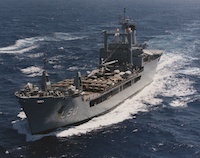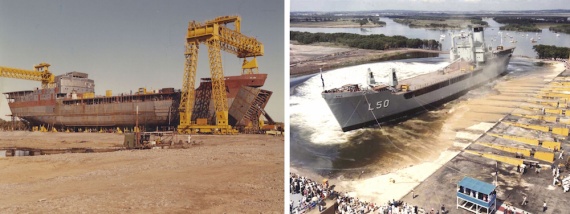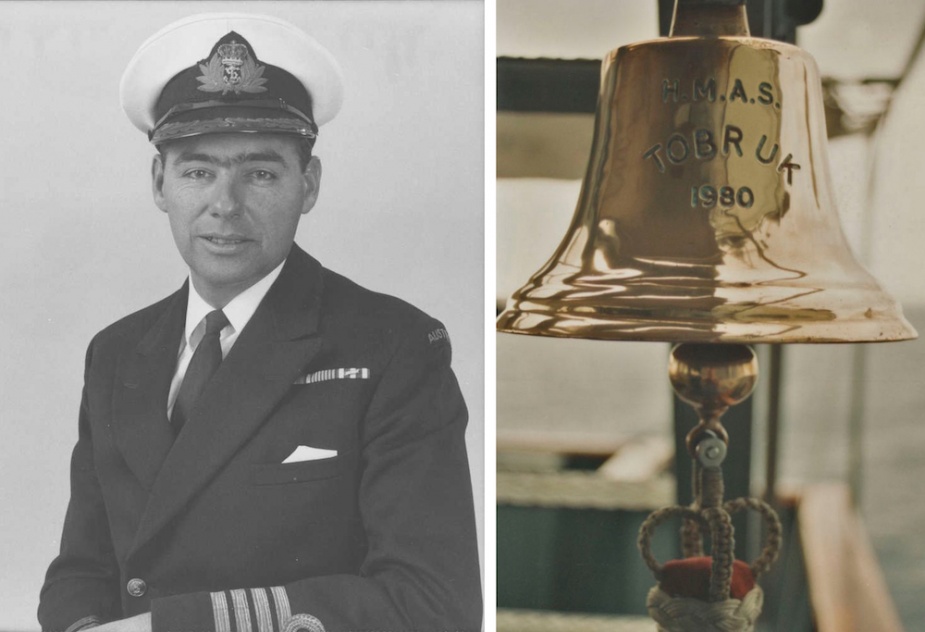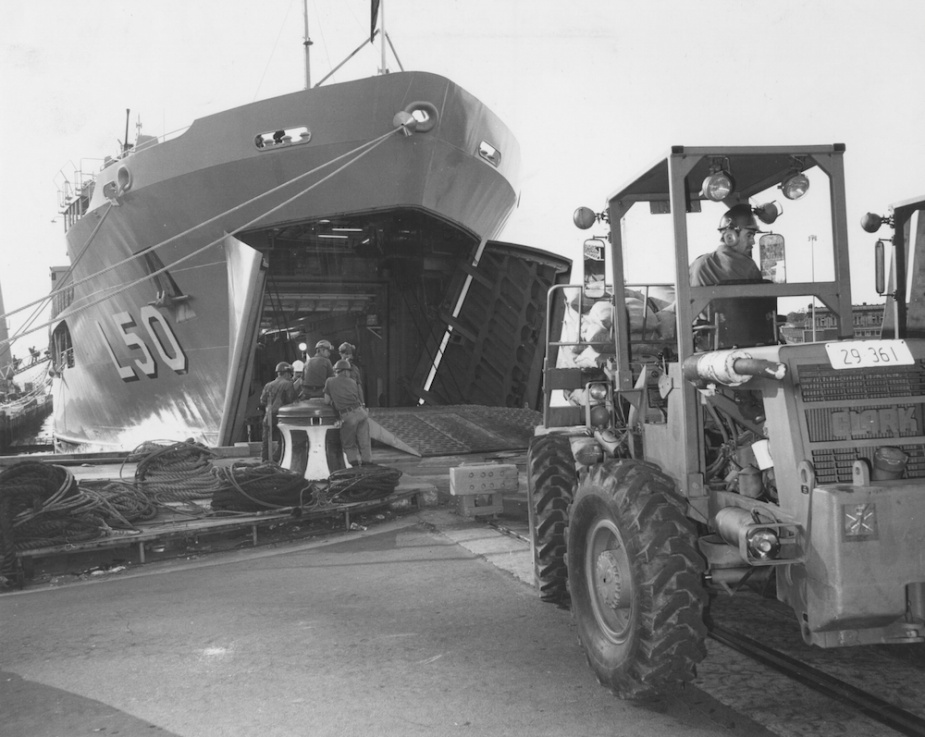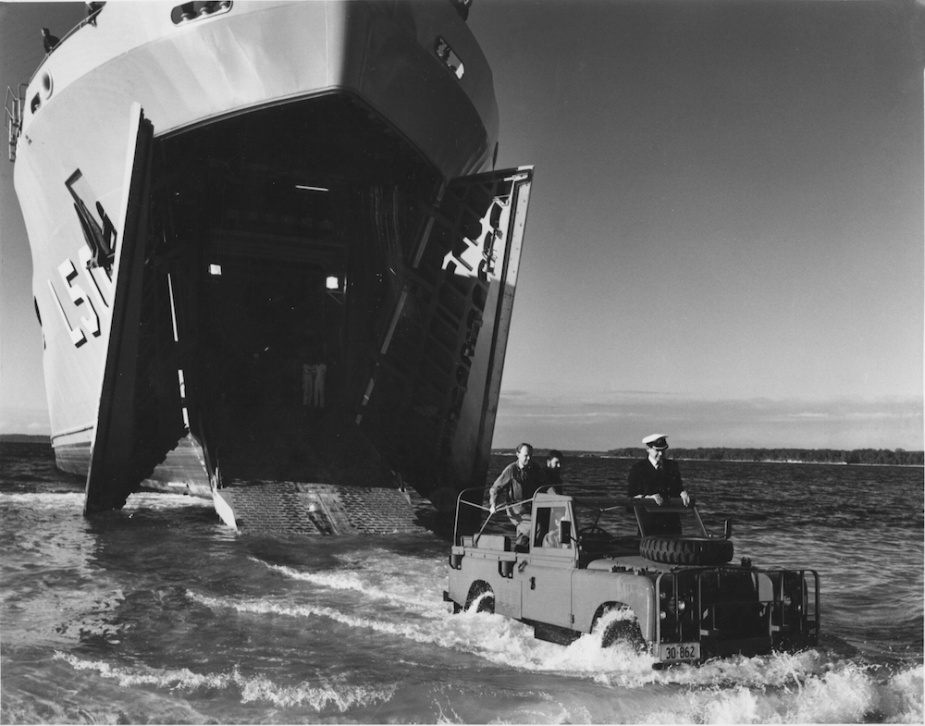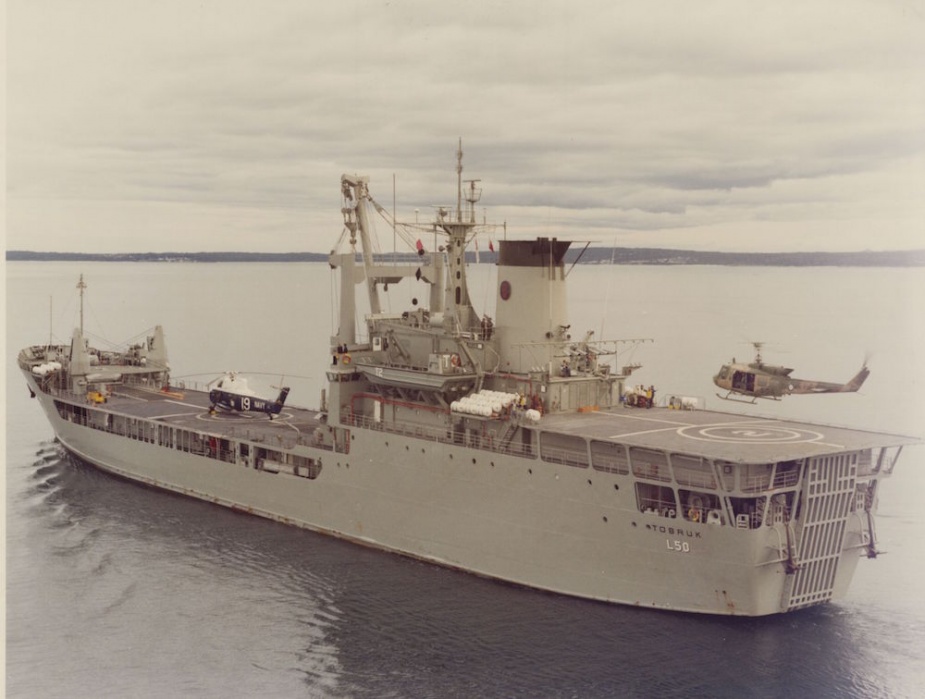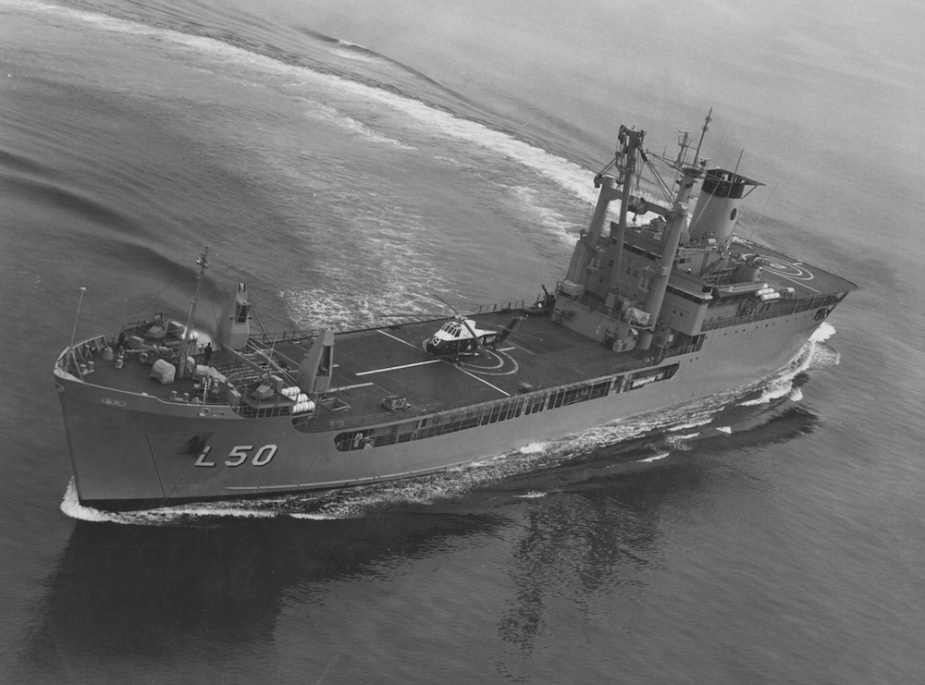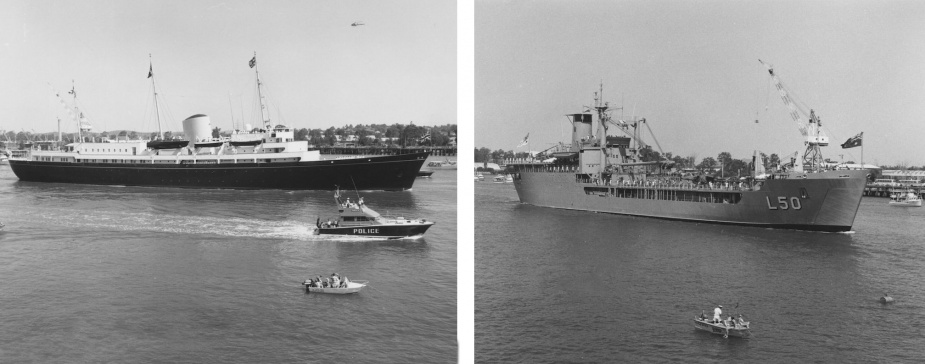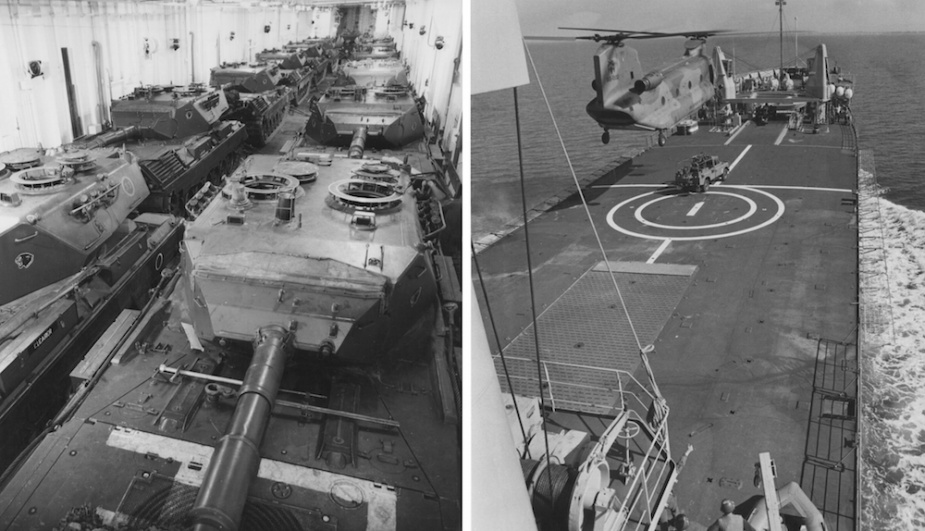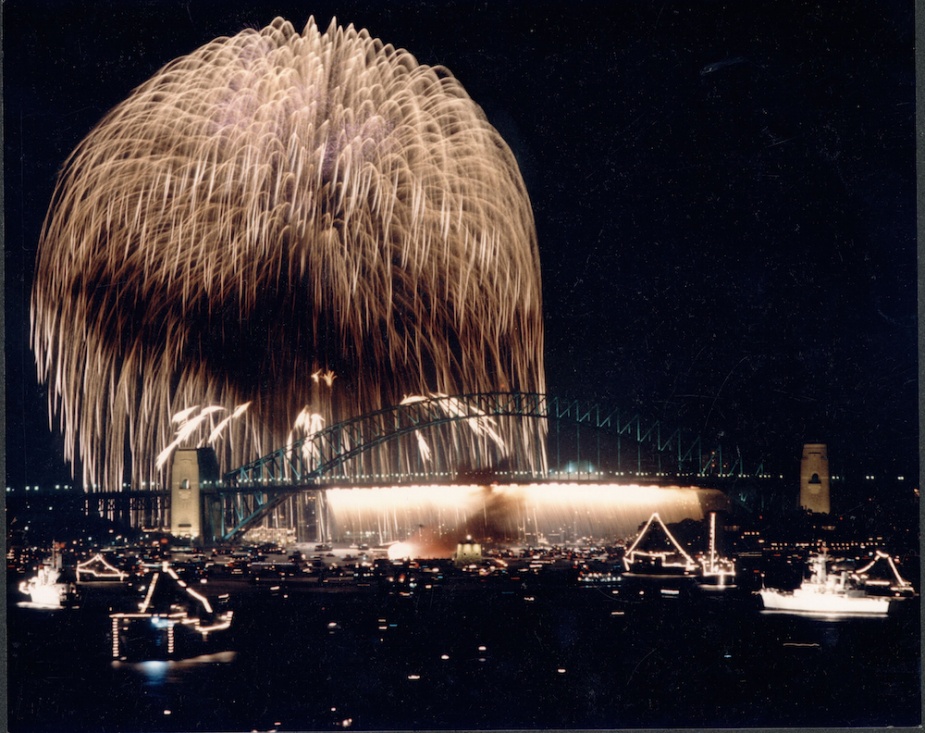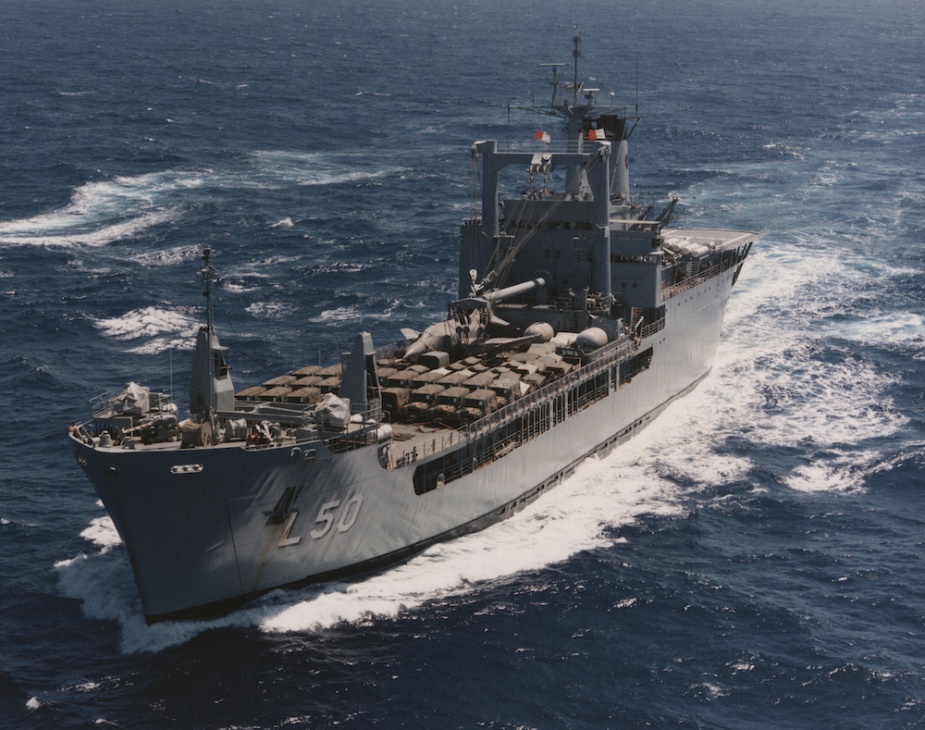HMAS Tobruk (II)
| Class |
Modified Sir Bedivere Class |
|---|---|
| Type |
Landing Ship Heavy (LSH) |
| Pennant |
L50 |
| Motto |
Faithful and Strong |
| Builder |
Carrington Slipways Pty Ltd |
| Laid Down |
7 February 1979 |
| Launched |
1 March 1980 |
| Launched by |
Lady Anna Cowen |
| Commissioned |
23 April 1981 |
| Decommissioned |
31 July 2015 |
| Dimensions & Displacement | |
| Displacement | 5800 ton |
| Length | 127 metres |
| Beam | 18 metres |
| Performance | |
| Speed | 17 knots |
| Complement | |
| Crew | 150 |
| Embarked Forces | 520 |
| Propulsion | |
| Machinery | 2 x 54 ton, 4,800bhp Mirrlees-Blackstone KDMR8 diesel engines |
| Armament | |
| Guns |
|
| Helicopters | In support of Amphibious Operations (ranging from the Squirrel AS350-B to Chinook CH47) |
| Awards | |
| Inherited Battle Honours | |
| Battle Honours | |
| Resources | |
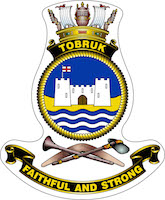
The amphibious heavy lift ship, HMAS Tobruk (II) was laid down at Carrington Slipways Pty Ltd at Tomago on the Hunter River, NSW, on 7 February 1979. She was launched on Saturday 1 March 1980 by Lady Anna Cowen, the wife of the then Governor-General of Australia Sir Zelman Cowen AK, GCMG, GCVO. She departed Tomago under her own power on 16 December 1980 and proceeded down the Hunter River for Newcastle. She was fitted-out and underwent harbour trials early in 1981.
The first aircraft landed on Tobruk on 15 January 1981 when a Wessex helicopter touched down on the ship’s flight deck as part of the trials. She commissioned on 23 April 1981 under the command of Commander Ken Doolan, RAN, who was promoted to Captain that June. Lady Cowen also presented the Tobruk Cup during the day, awarded for inter-mess competition.
Tobruk was designed for combined Navy and Army amphibious operations; essentially a multi-purpose troop and roll-on/roll-off, heavy vehicle carrier with facilities for bow and stern loading, beaching, a drive-through capacity and inter-deck transfers via ramps.
Upon commissioning, she could transport up to 18 tanks in the tank deck, and more than 40 Armoured Personnel Carriers or Light Armoured Vehicles on the vehicle deck, which had been reinforced to enable the transportation of two Landing Craft Mechanical-8s (LCM-8) on specially designed cradles. In addition, two Landing Craft Vehicular Personnel units (LCVP) could be secured by davits on either side of the superstructure. The ship's roll-on/roll-off function was supplemented by two 8.5 ton cranes and a 70 ton derrick. She had forward and aft helicopter decks, which could be operated simultaneously, and could provide accommodation for up to 520 troops.
Tobruk put to sea on 27 April for shakedown exercises and to commence passage to her home port of Brisbane. She anchored in Moreton Bay on 30 April and made a ceremonial entry into Brisbane the following day. The next few weeks were occupied with shakedown exercises and trials in eastern Australian waters. The ship visited Sydney for the first time on 14 May before commencing first-of-class flying trials in Jervis Bay on 20 May with the arrival of a Wessex 31B helicopter on board. By the end of the month, 404 landings and take-offs had been conducted on Tobruk's two flight decks by Wessex, Iroquois UH-1H and Iroquois UH-1B aircraft. She returned to Brisbane in early June and trials continued off the Australian east coast, including further flying trials with Chinook CH-47C and Bell 206B-1 helicopters, as well as training of RAN Reserves and Reserve Cadets.
She participated in Exercise BRIDGING TRAIN in August during which she conducted beaching trials and loading and off-loading of Army heavy vehicles. The following month, trial evolutions began to decrease and Tobruk started to settle into a routine program of exercises, training and maintenance. She visited Adelaide for the first time in October and, en route, participated in the search and rescue for personnel from the yacht Escapade, which had been reported sinking off Port Stephens. Tobruk spotted two survivors in a life raft shortly before 4:00am on 9 October and directed a police launch to their position to be rescued. She participated in the major multi-national, amphibious exercise KANGAROO 81 later in the month.
The year ended in tragedy aboard Tobruk when Naval Reserve Cadet Kenneth Dax, on board with 29 other cadets for sea training, collapsed in one of the ship's bathrooms on 11 December. In spite of first aid being swiftly applied and his medical evacuation to Royal Brisbane Hospital, Dax never resumed consciousness and passed away on 16 December 1981. Subsequent investigations found that Dax had been asphyxiated by a hydrogen-sulphide gas leak in the ship's sewage system.
1982 - 1985
On 16 February 1982, Tobruk embarked eight Royal Australian Air Force (RAAF) Iroquois helicopters as well as other RAAF stores and equipment for passage to Ashdod in Israel. The Iroquois flight was to serve as part of the ten-nation Multi-national Force and Observers (MFO) in the Sinai Peninsula, which also included RAN personnel, as part of the peace treaty between Egypt and Israel.
Tobruk departed Sydney on 18 February and arrived in Ashdod, via Fremantle, on 19 March having passed through the Suez Canal the previous day. She departed on 23 March and arrived back in Brisbane, via Singapore and Penang where she embarked two RAAF Iroquois and other vehicles for transport back to Australia, on 30 April. While en route from Penang, Tobruk embarked 13 New Zealand Army soldiers for sea experience and training, as well as an old pearling lugger which had been acquired by the Queensland Maritime Museum Association for restoration and display.
On 26 and 27 May, over the course of 22 hours, more than 800 tonnes of cargo, including food and building equipment, was loaded for transport to cyclone affected Tonga and Vanuatu. Tropical Cyclone Isaac struck Tonga in early March and was the worst storm in Tonga's history, claimed six lives and leaving some 45,000 homeless. Tobruk departed Sydney for Nuku’alofa on 27 May and arrived on 2 June. She departed the next day for Vila, Vanuatu, where, on 6 June, she unloaded Defence Co-operation Program cargo for the Vanuatu police. She departed the following day and arrived back in Brisbane on 10 June.
Tobruk participated in Exercise GRAND ROYALE at the end of September joining HMA Ships Hobart and Torrens, HMA Submarine Otama and HMNZS Otago to escort HMY Britannia, with His Royal Highness the Duke of Edinburgh embarked, along the Queensland coast towards Brisbane. Britannia led the formation into Brisbane on 29 September as part of the Twelfth Commonwealth Games festivities.
Tobruk's Army support role came to the fore in 1982 as she participated in the Army exercises SEA STRIKE, DIAMOND DOLLAR, GLENCOE, MARLIN MOVE, SAND CRAB and PREMIUM BOND during the course of the year. She also participated in squadron exercises in December. She was a regular participant in both Army and Navy exercises throughout the course of the decade, as well as providing support to the RAAF, and participated in Exercises; NORTHERN SEARCH, DIAMOND DOLLAR and KANGAROO in 1983; SEA STRIKE, TRIDENT LOVE and DIAMOND DOLLAR in 1984; FLYING FISH, INITIAL LANDING, ARNHEM PHOENIX, TORRES TREK, DIAMOND DOLLAR, CORAL SEA and TASMAN WARRIOR in 1985; INITIAL LANDING, DIAMOND DOLLAR and FULL PACK in 1986; INITIAL LANDING, DUSTY TROOPER, VALIANT USHER, DIAMOND DOLLAR and PREDATORS RETREAT in 1987; INITIAL LANDING in 1988; and KANGAROO in 1989. She was also a regular participant in Fleet Concentration Periods throughout the decade.
She participated in the Fleet Concentration Period in February 1983 before setting course for Penang and Singapore to back-load cargo in support of the RAAF's withdrawal from RAAF Butterworth ahead of the handover of the base to the Royal Malaysian Air Force in 1988. She arrived back in Darwin on 20 March.
She visited New Zealand in February and March 1984 to participate in Exercises NORTHERN SAFARI and AUCKEX conducting exercises with armed forces from New Zealand, Great Britain and the United States. She arrived back in Sydney on 2 April.
Tobruk visited Sydney early in August to embark stores in preparation for her deployment to the South Pacific nation of Tuvalu in support of the fifteenth South Pacific Forum. She departed Sydney on 10 August and arrived in Funafuti, the capital of Tuvalu, via Vila, on the 18th. The ship provided accommodation for 35 officials from 12 of the 14 national delegations, and for a week from 21 August, acted as a training vessel for cadets from the Tuvalu Maritime School. On 26 August Tobruk embarked the 14 chief delegates including 12 heads of state, the Prime Ministers or Presidents of; Australia, Cook Islands, Federated States of Micronesia, Fiji, Kiribati, Nauru, New Zealand, Nieu, Papua New Guinea, Tuvalu, Vanuatu and Western Samoa, as well as the Solomon Islands' Minister for Natural Development and the Tongan Minister for Foreign Affairs and Defence. The Forum concluded on 28 August and Tobruk departed Funafuti two days later. The ship and her crew had made a particularly positive impression during the Forum with Prime Minister Bob Hawke noting that Tobruk had contributed significantly and positively to Australia's standing in the region while the Attorney-General of Funafuti stated that the ship's crew showed unstinting helpfulness and friendliness.
At the end of September and beginning of October, Tobruk visited Melbourne and Sydney where she embarked Army equipment to participate in Exercise DIAMOND DOLLAR in Queensland. On 1 October she departed Sydney with cargo which included 18 main battle tanks and 36 armoured personnel carriers, as well as other stores, equipment and personnel amounting to some 1230 tonnes; the heaviest load yet carried by the ship.
1986
Tobruk departed Brisbane on 11 January 1986 for her new home port of Sydney, her departure coinciding with the opening of the Gateway Bridge with an estimated 200,000 people turning out. Tobruk arrived in Sydney on 13 January and immediately began pre-refit preparations. While the ship was high-and-dry at Cockatoo Island Dockyard, members of the ship's company conducted a charity 'cyclathon' from Canberra to Sydney in April to raise money for the Prince of Wales Children's Hospital and the Royal NSW Institute for Deaf and Blind Children. Having stopped overnight at Mittagong, the team arrived at the Channel 10 studios in Sydney at 3:45pm on 5 April having raised $5535.62 for two worthy charities.
Tobruk was back at sea on 2 July and began a series of post-refit trials and work-up exercises. On 15 July while conducting work-up exercises in Jervis Bay, Tobruk was signalled to go to the assistance of a Sea King helicopter which had ditched in the sea some 40nm east of Kiama. The five man crew of the helicopter were all rescued by a second Sea King launched from HMAS Albatross, however, in spite of the best efforts of Tobruk, HMAS Adelaide and a detachment from Clearance Diving Team One, the aircraft was lost in more than 350 metres of water.
That October, Tobruk participated in the Royal Fleet Review commemorating the 75th Anniversary of the granting of the Royal Assent to the Royal Australian Navy.
A detachment from the ship's company participated in the Combined Navies March on 2 October, and on the 4th, the ship took up her assigned position near Fort Denison as His Royal Highness, the Duke of Edinburgh conducted his review from aboard HMAS Cook. Tobruk recommenced her routine program of exercises, training and maintenance on 7 October.
1987
The ship deployed to the South Pacific in February 1987 with a detachment from Clearance Diving Team One embarked to conduct channel clearance operations in the Solomon Islands. Also embarked were 51 midshipmen undertaking second year studies at the Australian Defence Force Academy (ADFA) as well as nine officers from foreign navies. She arrived in Honiara on 2 February where she delivered an operating table and 14 cartons of books donated to the Honiara Hospital and the King George VI School respectively. While channel clearance operations were underway, the ship's company organised working parties ashore to conduct community aid tasks.
The ship set a course for Papua New Guinea on 12 February where the remains of four World War II era Boston Bomber aircraft, as well as other wartime relics, were embarked for restoration and display at various museums in Australia and Papua New Guinea. She arrived back at Townsville on 24 February where the ADFA midshipmen and foreign officers were disembarked. She returned to the Solomon Islands the following month with supplies for Australian aid workers who had been rebuilding facilities in the Solomons post-Cyclone Namu, as well as to back-load equipment used by Clearance Diving Team One during channel clearance operations. She returned to Sydney on 9 March.
Tobruk returned to the South Pacific in May, firstly to Fiji under the auspices of Operation MORRIS DANCE, the Australian Defence Force's contingency plan to evacuate Australian nationals in the wake of a military coup. She embarked two landing craft, two amphibious craft and five helicopters for operations in Fiji, as well as cars and motorcycles to provide transport support for members of the Australian delegation to the South Pacific Forum at Apia, Western Samoa. She departed Sydney on 21 May, embarked a detachment from the Operational Deployment Force at Norfolk Island on 24 May and she rendezvoused with other units assigned to MORRIS DANCE on 26 May. Troops and other units were transferred to other ships on that day and Tobruk continued on to Apia for the South Pacific Forum.
She arrived in Apia on 28 May and, in addition to providing transport support, provided accommodation for 40 delegates, officials and journalists, and catering services both on board and ashore. She participated in celebrations marking the 25th anniversary of the independence of Western Samoa on 1 June before departing two days later. She arrived back in Sydney, via Norfolk Island, on 12 June.
On August 6, Tobruk assisted in the search for two sailors lost from the submarine HMAS Otama, Able Seaman Hugh Markrow and Seaman Damian Humphreys. The two sailors had been lost three days earlier and numerous air and sea units were involved in search and rescue efforts. Tragically, neither Markrow nor Humphreys were ever found.
1988
The year 1988 got off to a festive start as Tobruk participated in a ceremonial Fleet Entry into Sydney Harbour as part of Bicentennial Australia Day celebrations before hosting some 280 guests on board for Australia Day Festivities.
She undertook an ADFA training cruise to New Zealand in February visiting Auckland and Lyttleton, and returned to Sydney on 19 February.
That April, the ship embarked Army equipment and personnel in Sydney for Operation IRON TRIANGLE. While alongside in Sydney, the crew presented a $1100 wheelchair, purchased through the ship's welfare fund, to seven-year-old spina bifida sufferer Emma Chapman. Tobruk provided logistic support for IRON TRIANGLE in South Australian waters in April and May, before embarking stores for Operation SAILCLOTH, the Australia Defence Force's contingency plan to assist Australian nationals in Vanuatu where rioting had swept through the capital, Port Vila, the previous week. Thankfully local police restored order in Vila and SAILCLOTH was suspended on the morning of 26 May.
On 2 September Tobruk began embarking equipment in support of the Bicentennial Military Tattoo. Two days later she embarked 233 members of the Tattoo Regiment as well as the RAN Personnel Liaison team and cast off for the first leg of the deployment. She spent the next three months circumnavigating Australia transporting the regiment and providing alongside support on its national tour. Her commitment came to an end on 30 November in Melbourne.
1989
Tobruk departed Sydney on 30 January 1989 bound for the west coast of the USA along with HMAS Canberra (II). She embarked Army vehicles and equipment in Brisbane before setting course for San Francisco via Honiara and Pearl Harbor. She arrived in San Francisco on 1 March and two days later, members of the crew embarked in the Oliver Hazard Perry class frigate, USS Wadsworth, for familiarisation training. Tobruk visited San Diego before participating in Exercise CALTROP FORCE with members of D Company 6 RAR embarked, and then proceeded north to Esquimalt, Canada, where she arrived on 29 March.
Army vehicles and equipment was re-embarked in San Francisco, along with an F-4 Phantom aircraft donated by the USAF to the RAAF Museum at Point Cook, and Tobruk departed the US west coast for home on 7 April. She arrived back in Sydney, via Pearl Harbor, the Solomon Islands and Brisbane, on 10 May having conducted training with USN ships en route.
Further reading
- https://seapower.navy.gov.au/sites/default/files/documents/Navy_News-May-8-1981.pdf
- https://seapower.navy.gov.au/biography/rear-admiral-kenneth-allan-doolan
- https://seapower.navy.gov.au/sites/default/files/documents/Navy_News-November-6-1981.pdf
- https://seapower.navy.gov.au/sites/default/files/documents/Navy_News-February-12-1982.pdf
- https://seapower.navy.gov.au/sites/default/files/documents/Navy_News-April-23-1982.pdf
- https://seapower.navy.gov.au/sites/default/files/documents/Navy_News-August-24-1984.pdf
- https://seapower.navy.gov.au/sites/default/files/documents/Navy_News-September-7-1984.pdf
- https://seapower.navy.gov.au/sites/default/files/documents/Navy_News-September-21-1984.pdf
- https://seapower.navy.gov.au/history/feature-histories/how-old-australia%E2%80%99s-navy
- https://seapower.navy.gov.au/sites/default/files/documents/Navy_News-October-17-1986.pdf
- https://seapower.navy.gov.au/sites/default/files/documents/Navy_News-March-20-1987.pdf
- https://seapower.navy.gov.au/sites/default/files/documents/Navy_News-May-29-1987.pdf
- https://seapower.navy.gov.au/sites/default/files/documents/Navy_News-February-5-1988.pdf
- https://seapower.navy.gov.au/sites/default/files/documents/Navy_News-April-28-1989.pdf
- https://seapower.navy.gov.au/sites/default/files/documents/Navy_News-November-6-1981.pdf
- https://seapower.navy.gov.au/sites/default/files/documents/Navy_News-May-26-1989.pdf

